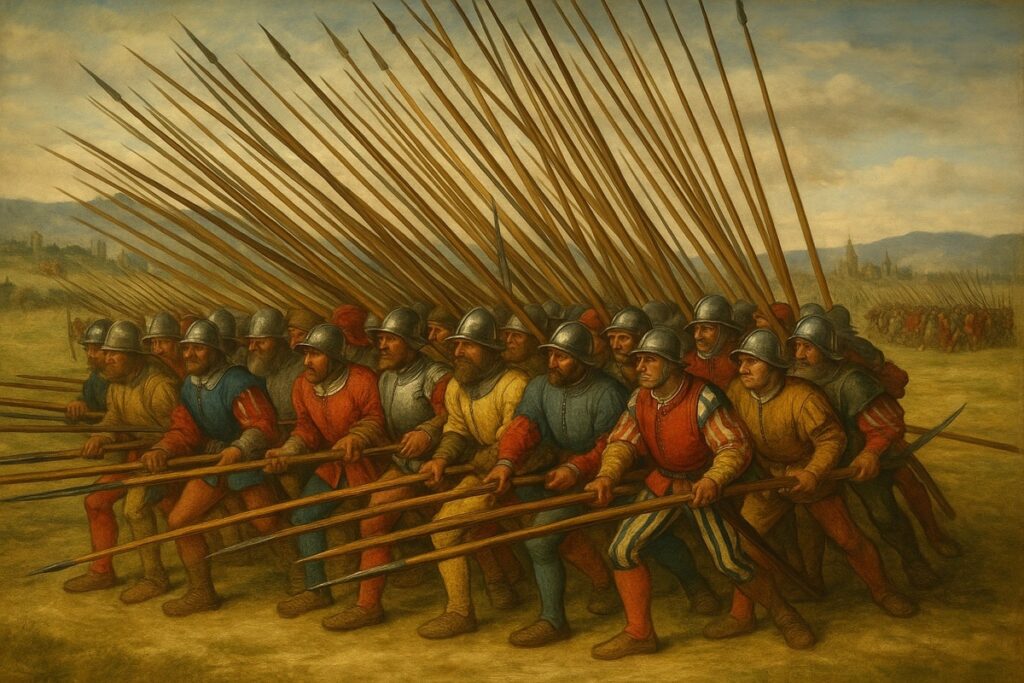A Cross – Cultural Martial Arts Comparison

This image of Swiss Pike fighting illustrates the disciplined, tightly coordinated formations that defined medieval martial success. Unlike chaotic skirmishes, Swiss pike squares emphasized unity, mutual trust, and psychological cohesion—values still echoed in modern martial systems.
I. Introduction: Formation as a Martial and Cultural Paradigm
Swiss Pike fighting offers a powerful example of collective martial discipline, emphasizing synchronized coordination, psychological resilience, and cohesion under pressure. Across cultures, such systems have served not just as tools of war, but as crucibles for ethical formation and communal identity. This article compares Swiss Pike tactics, the Greek hoplite phalanx, and Wing Chun wooden dummy training as expressions of social order, martial craftsmanship, and self-formation through structured group practice. From the Gewalthaufen to Tyrtaean phalanxes and ritualized solo drills, a common theme emerges: true strength lies in disciplined unity, not isolated skill. These traditions also echo deeper moral imperatives, including those from Christian liturgy and literary theology.
II. The Swiss Pike Square: A Martial Culture of Alignment
The late-medieval Swiss cantons forged an exceptional military identity through the disciplined use of the pike square—known as the Gewalthaufen, or “force-mass.” These formations prioritized cohesion, synchronization, and shared danger over individual martial flair. The pike, a weapon virtually useless in isolation due to its length, rigidity, and two-handed usage, became devastating when wielded by coordinated groups. The Swiss perfected its employment through elaborate drill systems, both individual and collective, allowing even agrarian militias to rout knightly cavalry and professional mercenaries.
Scholars have argued that the efficacy of the pike square was not merely tactical, but deeply cultural. Swiss society—egalitarian, agrarian, and communally self-reliant—cultivated a martial ethos that mirrored its civic values: horizontal cohesion over hierarchical display, communal defense over personal glory, and shared hardship as the basis of social solidarity.
These drills possessed what some historians have described as “liturgical qualities”: rhythmic footfalls, shouted cadence, and synchronized maneuvers that created psychological entrainment and spiritual cohesion. In this sense, the pike square functioned not only as a weapon but as a medium for cultivating virtues such as mutual trust, emotional regulation, and a deep identification with one’s place in the line.
III. The Phalanx and the Ethics of Standing
The same moral architecture underlies the classical Greek phalanx, particularly in the poetry of Tyrtaeus, a 7th-century BCE Spartan poet whose verses functioned as martial catechism in times of political and military peril. Written in the shadow of defeats such as the Battle of Hysiae, Tyrtaeus’ exhortations emphasize not ferocity or individual might, but the moral resolve to remain in formation under pressure:
“Let each man bear his shield straight toward the fore-fighters,
regarding his own life as hateful…
Those who remain in place…
die in lesser numbers and save the army behind them.”
Here, courage is redefined: not as the unbridled aggression of the Homeric hero, but as the restraint and endurance of the soldier who holds his place. The phalanx becomes a moral ecosystem in which failure is not the death of a single fighter, but the unraveling of trust. The collapse of one part of the line compromises the whole, making unity itself the condition for both tactical and moral survival.
IV. Crafting the Self: Wing Chun Wooden Dummy as Solitary Formation
At first glance, the solitary nature of Wing Chun wooden dummy training may appear to contrast sharply with the communal formations of pike and phalanx. Yet the underlying principle remains the same: the shaping of disciplined responsiveness through embodied repetition.
In Wing Chun, the practitioner trains not for spectacle, but for control, timing, and structure—qualities that, though honed alone, radiate outward into relationships and social conduct. Each contact with the wooden dummy becomes a dialogue between nervous system and structure, between intent and form. Like Swiss Pike Fighting, Wing Chun wooden dummy develops unity throughout our body. The dummy does not yield or adapt; the practitioner must.
This practice mirrors Richard Sennett’s conception of craftsmanship as “the long, patient pursuit of quality,” a process wherein hand and mind are jointly cultivated through tactile learning and the “dialogue with materials.” In this context, wooden dummy training becomes a practice not of violence, but of virtue. It cultivates internal stability, external sensitivity, and the ability to meet resistance with adaptability—skills as vital to communal life as to martial survival.
This “dialogue with materials” is presented in our systematic training curriculum: Explore how Wing Chun Wooden Dummy training mirrors the discipline of Swiss Pike formations
V. Liturgical Echoes: The Archangel Michael and Sacred Alignment
The ethical resonances of Swiss Pike Fighting martial formation find profound expression in the liturgical traditions of Christianity. In the Divine Liturgy of St. John Chrysostom, the Archangel Michael, in the wake of Lucifer’s rebellion, calls the faithful angels to formation:
“Let us stand aright! Let us stand with fear! Let us attend!”
This is not a battle cry, but a call to remain—aligned, obedient, and alert. It mirrors the logic of both the hoplite phalanx and the Gewalthaufen: that the line must hold, not through attack, but through fidelity. The angels do not counter the fall with violence but with steadfastness, preserving heavenly order through positional integrity.
John Milton’s Paradise Lost echoes this vision. In Book VI, Michael’s angels form “in mighty phalanx firm,” not for glory, but for the preservation of divine order. Their strength lies in obedience, their dignity in formation. In this way, standing in the line becomes a metaphysical gesture: an affirmation of faith, duty, and the moral geometry of solidarity.
VI. Philosophical Implications: The Contextual Nature of Power
Both the Swiss Pike Fighting and the Greek phalanx an important corrective to modern martial and cultural individualism. They remind us that:
- Not all power is individual; some forms of strength only exist in relation.
- Some skills have meaning only within structure and mutual alignment.
- Discipline, trust, and presence under pressure are virtues that must be cultivated communally, not merely personally.
The formation—whether martial, civic, or spiritual—is a medium for transmitting and embodying shared values. It shapes not only the body, but the soul.
VII. Formation and Faithfulness — The Heavenly Line in Paradise Lost
In Book VI of Paradise Lost, after the defeat of Satan’s rebellious host, the Son of God addresses the faithful angels:
“Stand still in bright array, ye saints. Here stand
Ye angels armed. This day from battle rest.
Faithful hath been your warfare, and of God accepted,
Fearless in His righteous cause.”
This solemn declaration echoes the spiritual and moral architecture of the hoplite phalanx and Swiss pike square. To stand in bright array is not merely to be visually impressive, but to embody discipline, loyalty, and divine order. The angels are still armed—not because they are at war, but because vigilance and formation are enduring states of fidelity.
Milton’s language mirrors the ethos of Tyrtaeus: the idea that to hold the line is a moral victory. In heaven, as on earth, order is not accidental—it is the result of volitional loyalty. The angels are praised not for conquest, but for obedience, for having endured in alignment with God’s righteousness.
“Faithful hath been your warfare” emphasizes that faithfulness is the true measure of valor, not just victory.
This reframes both celestial and terrestrial warfare: courage is sanctified not by bloodshed, but by alignment with what is just and true.
This heavenly commendation thus resonates with the spiritual depth of hoplite and pike traditions. In each, the true act of heroism is not found in aggression, but in remaining steadfast when rebellion tempts, fear rises, and pressure mounts.
Milton’s angels, like Tyrtaeus’ hoplites and the Swiss pikemen, stand as symbols of formation as faith. Whether on sacred ground, in civic defense, or before the throne of heaven, to stand firm in array is both a martial and spiritual act—a gesture of unbroken integrity in the face of chaos.
VIII. Conclusion: To Stand is to Preserve
A lone pike is a stick. A pike in formation is a wall of resolve. To stand in the line—whether on a battlefield, before a dummy, or in the face of cosmic rebellion—is to bear witness: to courage under fear, to discipline under strain, and to love of what lies behind you.
Tyrtaeus knew it. The Swiss knew it. The Archangel Michael knew it.
Let us stand aright. Let us stand with fear. Let us attend.
- https://en.wikipedia.org/wiki/Pike_square
- https://www.britannica.com/topic/phalanx-military-formation
Postscript: Notes on Terminology and Continuity
Gewalthaufen — A German term meaning “power heap” or “force-mass,” used to describe the tight, collective pike squares of Swiss and German foot soldiers. Beyond its tactical application, it denotes a cultural ethos of collective resolve.
Tyrtaeus 11 — A foundational fragment in the Spartan martial tradition, emphasizing cohesion, discipline, and the moral peril of disunity.
Wing Chun Wooden Dummy — A tool for embodied learning and internal alignment, training the practitioner to respond fluidly and precisely, both under pressure and in relationship.
Paradise Lost — Milton’s literary theology offers a vision of martial formation as a reflection of divine order, were obedience and unity counter rebellion and disintegration.
